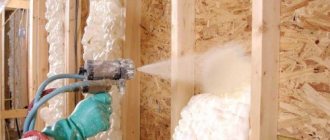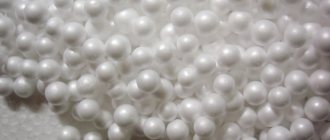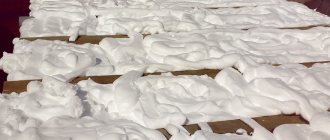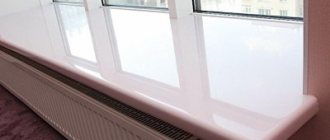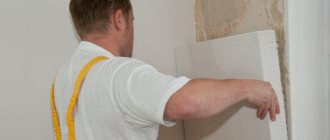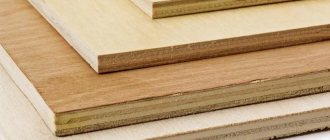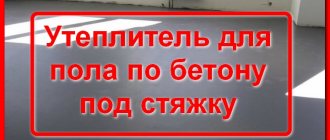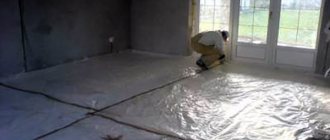Various heat-insulating materials with a cellular structure are sold on the market, one of them is penoizol. It differs from others in that an ordinary person can install or manufacture a plant that allows organizing the production of penoizol. Penoizol is an insulation material made from urea resin as a result of foaming. These materials are widely used in Russia; they are known as “Mipora”, “Mettemplast” or “Unipor”.
Installation for the production of penoizol
Penoizol is a functional and inexpensive insulation material, the production of which requires simple equipment and inexpensive raw materials. Therefore it is inexpensive.
Pros and cons of the material
In appearance, the material is very similar to marshmallow: just as white, airy, elastic and porous.
The thick foam mass allows you to insulate a house by filling air spaces in hollow walls and floors, as well as all cracks and crevices. As a result, the mass hardens, turning into porous insulation. (Read this article about the features of insulating a house with foam insulation). Due to its positive qualities, penoizol has a number of advantages:
- strength, efficiency and durability: the average service life is from 50 to 70 years;
- low thermal conductivity, which allows you to retain heat in the apartment and reduce energy costs;
- versatility: suitable for insulating floors, foaming walls and roofs;
- allows air to pass through, is hygroscopic, the structure of the material “breathes” and does not accumulate moisture;
- fire resistance: the material is not capable of burning; at high temperatures it simply evaporates slowly;
- rodents avoid penoizol, considering it inedible and tasteless;
- prevents the formation of mold and mildew;
- no reactions to organic solvents or chemical exposure;
- environmentally friendly, healthy material.
Disadvantages of penoizol:
- has a tendency to shrink;
- When drying, an unpleasant odor appears, which indicates that the material is of poor quality, and its production technology was violated.
Be careful: when buying penoizol, pay attention to how it smells - high-quality material should not have an unpleasant odor. For comparison, here are some of the disadvantages of a similar heat-insulating material, polystyrene foam:
- flammability;
- the material does not allow air to pass through;
- incompatibility with some materials, for example, wood;
- It is destroyed under the influence of the sun, despite its rigid structure.
These disadvantages once again emphasize the practicality of penoizol.
Interesting fact: expanded polystyrene looks like polystyrene foam, so they are often confused. In fact, they do have a lot in common and are made from the same material. The only difference is in the technology of their production.
How to choose the required insulation option?
Modern technologies in the field of construction make it possible to carry out thermal insulation work in 2 ways:
Insulating the wall from the outside
Pros:
- All work is carried out outside the living space, thereby not reducing its usable area .
- Additional layers of vapor and waterproofing completely limit the access of moisture to wall structures, preventing the development of fungal infections.
- A wall insulated on the outside loses heat 6 times slower than one insulated on the inside.
- Thanks to the external thermal insulation layer, the load-bearing wall element warms up and remains warm on both sides. The zero temperature point is outside the wall .
- Thermal insulation also plays the role of a soundproofing cushion.
Minuses:
- Difficulty in installation . In addition, if the building is multi-story, then the help of industrial climbers will be required.
- During insulation, the appearance of the building facade will change.
- Installation work can only be carried out under certain weather conditions (no precipitation, air temperature above +5 degrees )
Comparison of insulation methods
Internal insulation of wall structures
Pros:
- Internal insulation work can be carried out at any time of the year .
- This option for insulating the room will be more economical, since all the work can be done independently.
- You can insulate a separate room , not the entire building.
Minuses:
- Reduces the internal area of the room.
- The wall elements do not warm up completely, which prevents them from accumulating heat.
- During operation, condensation may form between the wall and the thermal insulation layer . Dampness is an excellent environment for the development of mold and mildew.
- A layer of insulation will make it problematic to attach shelves and other hanging elements to the wall.
- Heat loss through wall structures remains at 10-15%.
DIY production technology
When ready, the consistency of the mixture is similar to a soufflé. The substance hardens when it comes into contact with air. When applied, this mixture fills all voids. Therefore, the noise and thermal insulation characteristics of the room are improved after foaming the roof and other surfaces.
The material is convenient because work with it can be carried out all year round, regardless of weather conditions. Insulating houses with foam insulation gives the same result.
Types of equipment for do-it-yourself penoizol
Any premises can be used to set up production. But significant savings can be achieved if the process is organized in the same place where construction work is taking place.
The following types of devices are expected to be used:
- compressor;
- Electric Energy;
- pumps for solutions;
- foam generators. Their material matters;
- foam supply pumps;
- steam generator.
All equipment can be easily purchased on the construction market or in specialized stores. Including those working remotely via the Internet.
Devices are produced by different manufacturers, the main differences are in price and characteristics. 35 thousand is the average cost of the overall structure.
Russian and Ukrainian installations in this area give the best results. They are aimed at high-quality insulation of walls with foam insulation.
Additional Features Worth Paying Attention to
Additional characteristics that the equipment must have include the type of pump that is connected directly to the container with the main components. Pumps can be centrifugal, plunger, vortex, gear. They are all characterized by their advantages and disadvantages, so the choice should be made only after a complete review of all their advantages.
You should also pay attention to the generation that is typical for the equipment. Some devices that are commercially available today were produced back in the 90s. New samples are produced taking into account previously made errors in use.
Features of the material
Penoizol was developed at the end of the 20th century as a modern alternative to polyurethane foam, a proven insulation material that had a number of operational disadvantages. The main difference between the physicochemical properties of penoizol is that it retains its elasticity after foaming. This greatly increases its strength and useful life when insulating and soundproofing loaded structures, such as floors and ceilings. There are other features of the material:
- resistance to changes in temperature and humidity;
- immunity to biological threats: microbes, mold, insects, rodents;
- the fine porous structure promotes high vapor permeability;
- resistance to fire and high temperatures;
- environmental friendliness: does not emit harmful substances even when smoldering.
The elasticity of the material facilitates its installation in sheet form. When sprayed, the high adhesion and penetrating ability of the solution allows you to insulate both large surfaces and hidden cavities and hard-to-reach places.
Separately, it is worth noting the excellent sound insulation. Penoizol copes with both airborne noise and sounds transmitted through building structures.
The production of penoizol does not require special technical knowledge or particularly complex equipment and can be done with your own hands.
Key varieties
There are different types of urea foam. All of them are suitable for thermal insulation of buildings.
Penoizol can be used for thermal insulation of complex structures, interfloor ceilings and floors.
Main types:
- Liquid penoizol. Received the greatest distribution. It can be prepared directly on the construction site, which is why it is very convenient. The material is used for thermal insulation of various structures, as well as for repair purposes. Foam is poured into a confined space to form additional sound insulation in frame buildings. When it comes to repair work, penoizol in liquid form is used to fill cracks and gaps.
- Granular penoizol. It has several names: foam insulation crumb, thermal wool. It is available in the form of elastic granules. During manufacturing, the polymer is crushed into fractions up to 15 mm in size. The volume of the finished material after grinding doubles compared to the original amount. This is a good option to save on installation costs. Granular penoizol is used to fill the cavity between walls and for laying on the floor.
- Sheet foam insulation. The liquid material is poured into a special mold. After cooling, it is cut on special machines or simply by hand until it is given the required thickness. After this, they are dried and mechanically processed. The product is used to insulate buildings under construction. Installation is carried out with dowels from the outside of the walls. Decorative panels or siding are laid on top. In addition, the slabs are laid between the joists on the floor.
More information about the production of penoizol:
Penoizol can have different densities depending on the manufacturer. It varies on average from 6 to 35 kg per cubic meter.
Technical indicators
Compared to traditional insulation, penoizol has many advantages. The main characteristics worthy of attention include:
- Thermal conductivity. The only low figure is 0.041 W/m/K. To ensure good performance, it is enough to lay a layer 10 cm thick.
- Soundproofing. Noise absorption is at a quite decent level. It is approximately 65%.
- Fire resistance. The flammability group to which penoizol belongs is designated G-1. Its flammability category is B-2. This indicates that it will not melt when exposed to fire. When high temperatures are reached, the material will begin to evaporate, without producing toxic substances. Under the condition of an open fire, 10 times less smoke is generated compared to polystyrene foam.
- Resistant to chemical components. The insulation does not react in any way to aggressive environments. This primarily applies to solvents of organic origin.
- Resistance to humidity. Penoizol has the ability to absorb moisture well, but it gives it away with equal success. The characteristics of the material are not affected. It is capable of absorbing up to 1/5 of moisture. Penoizol subsequently evaporates it. To prevent mold from forming on the wall, install a ventilation gap. The heat insulator absorbs approximately 20% of moisture throughout the day.
- Vapor permeability. The insulation in question is hygroscopic, and therefore allows the walls to breathe. Air circulates freely throughout the structure.
Penoizol has good vapor permeability, which allows the walls to breathe.
Other characteristics include biostability. This means that penoizol is not afraid of fungi, pathogenic microflora, and domestic rodents. The material is soft, so it adheres closely to any uneven surfaces. It fills any gaps. With a linear deformation of 9%, the compression strength is 0.5 kg per square centimeter.
They started producing penoizol relatively recently, so we can only talk about its durability. It appeared on the market only 50 years ago. But manufacturers claim that it can last up to 30 years. Environmental friendliness is another advantage, since toxic compounds are not released either during installation or during operation.
Video on how to make a foam generator:
Sales markets
The main market for penoizol is construction organizations. You can sell products through retail chains. It is necessary to effectively advertise your products using:
- Internet;
- free advertisements in print;
- other sources.
Peak sales occur in the summer. In winter, the demand for these products decreases; this is not a winter business, although large construction projects take place all year round and they also need penoizol. It is necessary to begin sales in April to obtain greater profits. It should be taken into account that construction organizations make non-cash payments, which can be credited to the account within 90 days. With individuals, cash payments are made upon receipt of products.
| Name | Consumption rate | price, rub. | Total |
| Urea-formaldehyde resin, kg. | 25 | 12,5 | 312,5 |
| Foaming agent (ABSC), ml. | 0,5 | 75 | 37,5 |
| Orthophosphoric acid, ml. | 1 | 30 | 30 |
| Water, l. | 40 | 1 | 40 |
| Electricity, kW per hour | 8 | 3,5 | 28 |
The costs will pay off in about 7–8 months.
Scope of application
Penoizol is suitable for insulation and sound insulation of all types of building structures and elements. It is used for elements such as:
- floors and ceilings;
- walls, including frame walls;
- roofs and rafter systems;
- basement floors, foundations and blind areas.
Insulation of roofs with foam insulation
Sprayed foam insulation is perfect for correcting mistakes made at previous stages of construction. It can isolate the so-called. “cold bridges” through which intense heat leaks from heated rooms occur.
In addition to construction, the material is also popular in the production and thermal insulation of refrigeration equipment - from household models to industrial installations.
Separately, it is worth mentioning the use of penoizol as sound insulation in buildings located near highways or in noisy industries. A 50 mm layer of penoizol allows you to reduce the noise level several times and create more comfortable conditions for your stay.
Penoizol is used both for residential premises and for insulating domestic and outbuildings: garages, bathhouses, sheds for keeping farm animals, cellars.
A somewhat unusual area of application for penoizol is firefighting: foam is used to extinguish chemically active substances and energized installations. The sprayed material blocks the access of air and prevents further combustion.
Profit calculation
Calculation of profit of a penoizol production enterprise:
- income 550,000 rubles;
- production cost 300,000 rubles;
- profit 250,000 rubles.
Calculation of profitability of a penoizol production enterprise:
- revenue – 552,000;
- cost – 309,120;
- gross profit - 242,880;
- total expenses - 131,800;
- rent – 30,000;
- salary (including social contributions) – 71800;
- admin consumption – 10000;
- other expenses – 20,000;
- profit before tax – 111,080;
- income tax (USN) – 16,662;
- net profit – 94,418.
The above prices may vary and are provided as an example.
Disadvantages of the product
The main disadvantage of penoizol is that it produces sediment in the range of 0.1−5%. These indicators are better for the material that is between the walls under some pressure. Other disadvantages include:
- Low tensile strength. It's pretty easy to tear.
- Increased moisture absorption. In some situations this is a significant drawback. This feature prevents the use of this type of foam in the underground part of the foundation and when constructing a screed. It is necessary to lay additional waterproofing.
- The need to use special equipment. This is true for liquid forms of foam.
- Installation temperature requirements. It should be above +5°C. High-quality foam will only be obtained if this requirement is met. In addition, liquid urea foam can release phenol-formaldehyde during installation. This is possible if it contains low-quality resin.
Lathing for foam insulation thermal insulation
To ensure normal bonding of penoizol to the wall structure, it is necessary to construct a metal or wooden sheathing . If you choose a wooden option, you will need additional treatment of the frame elements with special antiseptics.
Sequence of installation of the sheathing structure:
- Mark the areas on the facade where the main elements of the sheathing will be attached to the wall;
- Drill holes for fasteners in the designated locations;
- Fill the holes with cement or gypsum mortar, and then, using a hammer, drive wooden plugs into them;
- Install the vertical elements of the sheathing and secure them using self-tapping screws (on clogged wooden plugs). The pitch of the guide bars is up to 1 m.
When using penoizol, there is no need to install film vapor or waterproofing . It will not allow the insulation to dry out, and the wall will not be able to breathe.
Horizontal elements are installed on vertical bars in increments of about 0.5 m.
You can start applying penoizol. Since this is a liquid material, an additional element of the lathing structure will be required - a restrictive mesh . It is attached to a frame with insulation to ensure the necessary fixation of the penoizol until it dries completely.
The last step is to install the finishing trim on the already insulated surface. In the same way, you can carry out internal thermal insulation of the room. In this case, plasterboard is used as a finishing material.
Just above we looked at the method of external insulation with foam insulation using a sheathing structure. Let's consider other options for insulating structures.
Production scheme and necessary ingredients
This inexpensive insulation is not difficult to produce, since cheap composites are used as raw materials. During production, a semi-liquid foam is made. After it hardens, an elastic material is obtained, on which any dents are immediately straightened out.
Sheets of finished penoizol
You will need the following ingredients to make penoizol:
- Urea-formaldehyde resin is the substance from which foam is made;
- Phosphoric acid - required for foam hardening;
- Foaming agent;
- Water.
The ingredients for making penoizol are pumped into the unit, where they are mixed and foamed with compressed air. After this, the finished product is supplied under pressure to the area that requires protection from the cold.
Freshly prepared foam resembles white jelly.
The composition hardens in a short time, 10-15 minutes after pumping to the required place from the generator, the foam only slightly sets, reaching full strength after 3 days. The solution will set completely after 1-3 days.
Installation diagram
You need to use a compressor of a certain power.
If you have high-quality foam with small pores, the area of its contact will become larger, as a result the polymerization process will improve. Polymerization is affected by the density of the foam. If the density is not enough (the bubbles will be large), then the foam will quickly settle. If this trouble occurs before the main part of the resin has polymerized, the composition in the mold will simply flow out.
The quality of the foam is affected by the water temperature; if it is low, the material will be of poor quality. There is a concept - foam multiplicity, which shows how much product will be produced from the solution. A high indicator is 60-80, with which you will have 60-80 liters of foam from 1 liter of prepared solution. You can find out this characteristic if you fill a 200 liter barrel with foam and wait until the bubbles disintegrate. Then the completely settled solution is measured. You can increase foaming slightly by adding more foaming agent to the solution.
Staff
To service the production, you need to hire 3 people, one of whom will be a senior person in the workshop. The latter’s responsibilities include coordinating the rest of the workers, monitoring their activity and training. It is the senior worker who needs to be sent for an internship to the equipment seller.
To organize sales, you will need a sales manager. He will meet and negotiate supplies with representatives of construction and wholesale and retail companies.
A driver is needed to deliver raw materials to the factory and finished goods to customers.
The accountant will handle the document flow and prepare papers for the tax authorities. It is better to hire one through outsourcing (by contacting an accounting firm).
Selection criteria and equipment purchase
In most cases, liquid penoizol is chosen when it comes to domestic use. It is applied using special equipment. You can rent it to save money.
To apply penoizol, a special installation is required; it can be rented in order to save
To produce penoizol with your own hands at home, you will need to equip the installation. You can arrange it from scrap materials. You will also need a compressor, molds for finished products, and additional equipment for lighting and ventilation. Budget installation options involve a combination of:
- gas-liquid equipment;
- supply hose;
- set of taps;
- plastic barrels;
- compressor.
Urea resins and catalyst are mixed in the plant. They are placed there using a pump. There is compressed air here. The main attention should be paid to the purchase of a pump, since it plays the role of a key element in production. Errors in dosage are especially important. A vortex or plunger pump is the most profitable and effective option. But in any case, foreign particles should not be allowed to get inside, as this will ruin the whole process.
More information about liquid foam:
Types of penoizol
Modern technologies have made it possible to create several types of materials, each of which has its own characteristics and differences. When foaming walls with foam insulation, this is also taken into account.
Liquid
Widely distributed in various spheres of life. A very convenient option due to the fact that it can be prepared directly on construction sites. Helps with repairs, provides protection against heat penetration. To additionally form sound insulation in frame buildings, foam is poured inside a confined space. During repairs, available penoizol helps fill cracks and gaps. It can also insulate.
Granulated
It is also called thermal wool or foam insulation crumbs. Release form: granules with a high degree of elasticity. During manufacturing, the polymer is crushed into fractions, each of which is 15 mm in size.
Compared to the original quantity, the volume of this mixture doubles after such grinding. A good option for those interested in cost-effective installation. Granular penoizol is laid on the floor, and the cavities between the walls are filled with it. The ceiling is easy to process.
Sheet
It involves pouring into a special form, in liquid form. The base is cut on special machines when everything cools down. Or they do everything with their own hands to give the structures the required shape and thickness. Next comes drying with mechanical processing. Insulation of buildings under construction is the main purpose of such materials.
During installation, dowels are used to cover the outer walls. The top of the wall is covered with decorative coverings. Slabs are also laid between the joists on the floor after producing penoizol with your own hands at home.
Total launch cost
The cost of the resulting product is the main indicator for any business; the production of penoizol is no exception. In this case, it is necessary to take into account the raw materials and production costs that will be needed to create 1 cubic meter of material. Expenses on electricity and wages for workers are taken into account. Their home may be somewhere else.
If the equipment is loaded at 50%, the final calculations for the business to begin with may look like this:
- 562 rubles – the average cost of 1 cubic meter, which is used to process a wall;
- the average selling price can be up to 800 rubles;
- from 1 cubic meter the manufacturer receives 263 rubles. The difference in types of material is insignificant;
- at half load of the equipment, the production volume will be 20 m3;
- per day profit 4760 rubles. This is an important characteristic;
- you can get about 100 thousand rubles per month;
- The payback period is on average up to 2 weeks. The homemade composition gives approximately the same result.
The main advantage is that you can get by with equipment with small dimensions. You can set up the whole process in literally 1-2 days. This applies to both the production of sheets and the use of the material directly on the construction site when it is liquid.
Modern mixing systems provide additional protection against the penetration of dust and dirt into installations. Even with improper operation, many types of equipment remain operational, and the technical quality parameter does not decrease.
Comparison with polyurethane foam
The two materials are often compared in terms of financial benefits and technical performance. Safety of use comes first in importance. Manufacturers claim that penoizol is neutral and safe for humans and animals. But at the same time, in a number of states in Canada and America there is a law according to which the use of urea foam for construction is prohibited. It is considered a potential health hazard.
This situation is also observed in some European countries. This is explained by the release of formaldehyde during the polymerization of liquid foam. You can reduce the likelihood of adverse effects by using a vapor barrier on the inside of the wall.
As for polyurethane foam, there are no bans on it in any country in the world. It has all the necessary quality and safety certificates.
In terms of water absorption, polyurethane foam has minimal indicators, since its structure is porous and closed. It retains heat well and is equipped with protection against corrosion, mold and mildew. The appearance of condensation is excluded here. Despite the positive properties of penoizol, excess moisture can lead to its destruction. This can be avoided by installing moisture insulation.
Strong humidity can lead to the destruction of penoizol
In terms of strength and physical and mechanical properties, penoizol is also slightly inferior. It is resistant to mechanical stress, but in this indicator it is still ahead of polyurethane foam. In terms of price, urea foam is an order of magnitude cheaper than polyurethane foam.
Documentation
First you need to register your activity form. You can work as an individual (IP) or legal entity (LLC). It all depends on the plans of the entrepreneur and the scale of production. Each form has its own capabilities and limitations, but working in the LLC form will allow you to cooperate even with large construction companies and wholesale and retail chains.
When registering, OKVED-2 codes are indicated.
23.99.6 “Production of mineral heat- and sound-insulating materials and products.”
22.23 “Production of plastic products used in construction.”
22.29 “Production of other plastic products.”
32.9 “Production of products not included in other groups.”
To start a business project, you do not need certification. The polymer is produced according to TU 2254-001-33000727-99 “Heat-insulating foam insulation. Technical conditions".
Premises for the production of penoizol:
The unit for the production of insulation can be located in any room. The main thing is that the building is closed and no precipitation gets into it. When working with equipment in winter, the room will have to be heated for better performance. The average temperature in it should be 15-20 degrees.
Use in winter
Work in winter is difficult, as problems are created due to low air temperatures. This factor adversely affects the structural composition of penoizol. Approximately 50% of the resin consists of water. For this reason, the viscosity of the material increases. Despite all these unfavorable aspects, penoizol can be poured under certain conditions. Its components must be stored in a warm room at a temperature of at least +15°C, for example in a garage.
The installation must also be placed in a warm place. You can install the cheapest tourist tent for this. The materials must be compactly rolled up, covered with a layer of plastic film, and then the fan heater installed. Before starting work, it is necessary to heat the solution to +40°C, and the resin to +20°C. For this, a regular boiler is used.
More information about do-it-yourself penozol:
If all these rules are followed, you can get penoizol that is no different from the material installed under normal conditions. It is unacceptable to keep it at a temperature below +15°C, as it does not dry well. The moisture it contains will freeze. It will fulfill its role as a heat insulator only with the onset of spring. Moisture that does not freeze in the spring will evaporate by itself. Dry foam will remain unchanged.
Equipment for making penoizol with your own hands
Now they produce many devices for the production of penoizol, among them there is equipment that allows you to make it yourself.
In this case you can:
- Buy a ready-made unit that contains a gas-liquid installation, the necessary set of taps and a hose for supplying foam. In addition, you will need a compressor and containers for a receiver with a capacity of 20-300 liters;
- Make your own device that produces penoizol using ready-made drawings.
Used installations for the production of penoizol are not worth buying. The reason is the wear and tear of the equipment, which will directly affect the quality of the finished insulation. In addition, the seller does not acknowledge the actual condition of the equipment. You can get into a lot of trouble by purchasing a used unit. It's better to buy a new unit right away.
If you decide to use the second option, you will need to find all the components for the production of penoizol:
Block diagram of installation of a plant for the production of penoizol
Equipment is divided into construction and workshop equipment. You should remember the important parameters that the installation for penoizol should have:
- Installation of the equipment is not difficult;
- The installation should be easy to use;
- Have the level of performance you require;
- Good mixing of components;
- The ability to change operating parameters is necessary;
- It is better to use equipment that is small in size and lightweight;
- High wear resistance is very important.
Important! When choosing a pump, take into account errors in the dosage of components, possible deviations from engine speed instability as a result of load changes and fluctuations.
Having purchased a package of documents, you can install the unit yourself, and spare parts are easy to purchase.
Foaming device
The design, which contains the most necessary components, will cost you inexpensively:
- Installation for the formation of bubbles in a solution;
- Hose for pumping foam;
- valve;
- Compressor of suitable capacity;
- Available materials;
- Barrels with a capacity of no more than 300 liters.
It is convenient to use vortex or plunger pumps, taking into account the material used in the manufacture of internal parts. It is better if they are plastic, ceramic, stainless steel, or at least plated with nickel.
It is also better to buy a plunger pump designed for pumping foam to the place of self-insulation. The foam is formed at low pressure in a special generator. In this case, double foaming is more effective; the output is semi-dry penoizol, so it will not simply flow out of the cavity. Install one pump to supply resin and a second one to pump foam. along the hose.
The compressor needs sufficient power; when choosing it, resin consumption is taken into account, which should not exceed 25 kg to obtain high-quality material.
Foam generator diagram
If you need penoizol for your home, then it is convenient to install the equipment directly on the construction site.
First, mix a concentrated mixture of hardener and foaming agent. For 10 liters of concentrate you will need 0.25 liters of orthophosphoric acid and 0.5 liters of foaming agent, all diluted in 10 liters of water heated to 60-80 degrees. The solution is mixed well, when there are no clots or lumps in it, the concentrate is ready, it can be stored in this form for up to 6 months. 1 liter of pre-mixed concentrate is poured into a prepared container of 10 liters of warm water.
Preparation of the State Housing Administration
To prepare you need:
- check the correct connections of the hoses to the components of the installation, the integrity of the electrical wiring;
- connect sources of compressed air and electricity to the installation;
- connect containers B2 and B3 to each other and connect to the GZHU according to the structural diagram directly to the suction fitting of the FOAM solution supply pump using flexible hoses with an internal diameter of 12 mm;
- container B1 with resin is connected to the installation directly to the suction fitting of the resin supply pump using a flexible hose with a diameter of 25 mm.
The height of the location of the drain fittings of containers B1-B3 relative to the FOAM and RESIN fittings of the installation must be at least 0.5 meters. Preparation of a 4% foaming agent solution:
- 0.1 liters of PO are consumed per 1 m3; if 20 cubic meters of penoizol are produced per shift, then it is necessary to prepare 2 liters of PO and dilute it with water 1:24 to obtain a 4% solution, i.e. 48 liters of water;
- A 4% solution of ABSA (PO) is prepared in hermetically sealed containers made of polyethylene or stainless steel;
- 2 liters of concentrated ABSA is diluted in 48 liters of hot water (70-80 °C) and stirred for 5-8 minutes. until a homogeneous transparent light brown liquid is obtained.
Preparation of foam solution:
- take 500 ml of phosphoric acid 85% concentration;
- pour 45 liters of water heated to 40 °C into a plastic container (50 l.);
- Pour KO into heated water and stir;
- Pour 5 liters into the prepared solution. the previously prepared 4% PO solution and mix thoroughly for several minutes.
The resulting FOAM solution is enough to produce 2 cubic meters. m. penoizol with a density of 15 kg/m3. Pouring foam into molds:
- pour RESIN and FOAM solutions into containers B1 and B2;
- open the tap for supplying the FOAM solution to the installation;
- open tap KP4 on the top panel of the installation for 2-3 minutes to allow the FOAM solution to flow into the working part of the electric pump H2.
The filling can be monitored visually through the transparent hose. Open the supply valve to the RESIN solution installation:
- open tap KR5 on the top panel of the installation for 2-3 minutes to allow the RESIN solution to flow into the working part of the electric pump H1, visually monitoring the filling.
- turn on both electric pumps for a short time (3-5 seconds) and make sure that they are working according to the readings of the pressure gauges (the “RESIN” pressure gauge should show more than 0.4 MPa (4 kgf/cm2), the “PENA” pressure gauge more than 0.3 MPa);
- After making sure that the pumps are working and the connections are tight, turn off the electric pumps;
- turn on the source of compressed air (compressor) and make sure that it flows through the air outlet from the outlet hose;
- turn on both pumps and start pouring the foam into the molds.
During short breaks in operation (up to 5 minutes), the installation can be stopped by turning off the electric pumps for supplying RESIN and FOAM solutions and stopping the air supply. It happens:
- in 10 minutes before finishing work, pour hot water (45-50 degrees Celsius) into container B3 for rinsing (at least 30 liters of hot water are required for rinsing);
- after making a decision to stop work, it is necessary to open the water supply tap KR3 to the installation;
- As soon as the water flows along the RESIN supply line, close the KR1 valve supplying the RESIN solution to the installation.
Rinse the resin line and outlet hose for 5-10 minutes. Then rinse the PENA line for 3-5 minutes. It is recommended to cut urea foam into slabs with a thickness of at least 4 cm and no more than 20 cm. The waste generated during cutting is placed in a separate container. After filling, the container is sent to dry. Cut foam slabs are placed on drying shelves and kept in the drying area for 2-3 days.
Dried waste is crushed in accordance with the Unipor crushed specifications. The crumbs are packaged in plastic bags for subsequent sale. In the finished products warehouse, finished foam boards and plastic bags with crumbs are stored until they are sold.
On video: Installation for the production of PENOIZOL
https://youtube.com/watch?v=UxY97KsmKgU
Commercial benefit
Penoizol finds its application in everyday life and commerce. Due to its low cost, this is a very profitable type of business, which involves the production and sale of penoizol in a liquid state or ready-made frozen sheets.
The sale of penoizol does not cause any particular difficulties, such as the process of its manufacture, which is a profitable trump card in the hands of a good entrepreneur.
Watch the video in which the user shares his experience of making penoizol with his own hands:
conclusions
We must separately remember that many companies prefer a non-cash form of payment, which is why the money arrives in the account with some delay.
It is advisable to provide in advance not only for wholesale, but also for retail sales. This will ensure a regular flow of funds. This is a good start for aspiring entrepreneurs.
Even if he is far from construction, he is just looking for his niche. The business is easy to start with minimal investment and has an average payback period.
